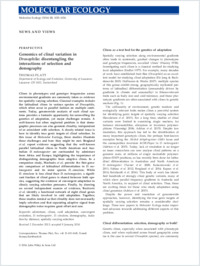Genomics of clinal variation in Drosophila: disentangling the interactions of selection and demography
- Flatt, Thomas Department of Ecology and Evolution, University of Lausanne Switzerland
-
2016
Published in:
- Molecular Ecology. - 2016, vol. 25, no. 5, p. 1023–1026
English
Clines in phenotypes and genotype frequencies across environmental gradients are commonly taken as evidence for spatially varying selection. Classical examples include the latitudinal clines in various species of Drosophila, which often occur in parallel fashion on multiple continents. Today, genomewide analysis of such clinal systems provides a fantastic opportunity for unravelling the genetics of adaptation, yet major challenges remain. A well‐known but often neglected problem is that demographic processes can also generate clinality, independent of or coincident with selection. A closely related issue is how to identify true genic targets of clinal selection. In this issue of Molecular Ecology, three studies illustrate these challenges and how they might be met. Bergland et al. report evidence suggesting that the well‐ known parallel latitudinal clines in North American and Australian D. melanogaster are confounded by admixture from Africa and Europe, highlighting the importance of distinguishing demographic from adaptive clines. In a companion study, Machado et al. provide the first genomic comparison of latitudinal differentiation in D. melanogaster and its sister species D. simulans. While D. simulans is less clinal than D. melanogaster, a significant fraction of clinal genes is shared between both species, suggesting the existence of convergent adaptation to clinaly varying selection pressures. Finally, by drawing on several independent sources of evidence, Božičević et al. identify a functional network of eight clinal genes that are likely involved in cold adaptation. Together, these studies remind us that clinality does not necessarily imply selection and that separating adaptive signal from demographic noise requires great effort and care.
- Faculty
- Faculté des sciences et de médecine
- Department
- Département de Biologie
- Language
-
- English
- Classification
- Biological sciences
- License
-
License undefined
- Identifiers
-
- RERO DOC 324330
- DOI 10.1111/mec.13534
- Persistent URL
- https://folia.unifr.ch/unifr/documents/307573
Statistics
Document views: 80
File downloads:
- pdf: 98
